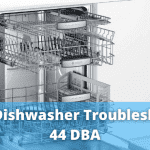Table of Contents
Need help with a KitchenAid dishwasher not cleaning dishes properly? There’s no need to wring your hands in despair.
The solution could be simpler than you think! Several factors might impede your dishwasher’s performance, and fortunately, many can be rectified without needing professional assistance.
| Problem | Potential Causes | Possible Solutions |
|---|---|---|
| Poor Cleaning | Improper loading of dishes, low water temperature, poor water quality, improper use of detergent | Load dishes properly, ensure water temperature is at least 120°F, test water quality and treat if necessary, use recommended dishwasher detergent |
| Noise | Loose utensils, damaged pump, defective wash arm, worn out bearings | Secure utensils, replace pump, replace wash arm, replace bearings |
| Not Drying Dishes | Poor loading of dishes, defective heating element, inadequate use of rinse aid | Load dishes properly, replace heating element, refill rinse aid dispenser |
| Not Draining | Clogged drain, faulty drain pump, blocked air gap (if installed) | Clean drain, replace drain pump, clear air gap |
| Leaking | Worn out door seal, loose connections, cracked tub | Replace door seal, tighten connections, replace tub |
| Not Starting | Faulty door latch, defective control board, bad timer | Replace door latch, replace control board, replace timer |
1. Dishwasher Loading Mistakes
One of the most common culprits behind a KitchenAid dishwasher needing to clean better is incorrect loading. Overcrowded racks or items obstructing the spray arms or detergent dispenser may limit the reach of water and detergent. Remember the golden rules:
- One dish per slot: Overlapping is a no-go; each item needs space.
- Face items inward: Place dishes facing inward and bowls/glasses upside down.
- Avoid obstruction: Ensure nothing is blocking the spray arms and detergent dispenser.
2. Hard Water Issues
Hard water, full of minerals like calcium and magnesium, can leave spots and residue on dishes. It can also interfere with the effectiveness of your detergent. Combat this by:
- Using a rinse aid: It helps reduce surface tension, thus enabling easy rinsing.
- Running a longer drying cycle ensures dishes dry completely, preventing spots.
- Installing a water softener: A surefire solution to remove minerals from your water supply.
3. Dishwasher Needs Cleaning
Ironically, your dishwasher needs a thorough cleaning now and then. Dirt and debris accumulation could cause blockages that leave dishes dirty. Clean the filter, spray arms, and tub regularly to maintain optimal performance.
4. Detergent Issues
The wrong amount of detergent or a faulty dispenser could leave your dishes dirty or soapy. Use a high-quality commercial dishwasher detergent, measure the right amount, and ensure the dispenser works correctly.
5. Water Supply Problems
Your dishwasher needs the appropriate temperature and volume of water. Check to see if the pressure and temperature of your water supply are enough. If necessary, adjust your home’s water pressure or water heater temperature.
Is Your KitchenAid Dishwasher Not Draining?
Here’s What To Next!:
If your KitchenAid dishwasher isn’t draining properly, it can be due to various reasons, from a clogged drain to a faulty drain pump. The good news is that with a little knowledge, many of these problems may be identified and resolved. And remember, if troubleshooting doesn’t solve the problem, it’s time to utilize that KitchenAid warranty.
How To Reset KitchenAid Dishwasher Included Control Panel Reset
Sometimes, your KitchenAid dishwasher might encounter issues that a simple reset can solve. This procedure can solve minor electronic glitches and restore normal functionality to your appliance. It’s one of the first steps to take before considering more serious interventions like repair or replacement.
KitchenAid Dishwasher Warranty & Their Drawbacks
KitchenAid offers a limited warranty on its dishwashers, providing coverage for any defects in material or workmanship. While this assurance from the manufacturer is a plus, there are some drawbacks. Normal wear and use, abuse, or problems resulting from poor installation are not covered by the guarantee. Also, an authorized KitchenAid service provider must perform the warranty service.
Famous KitchenAid Models
The KitchenAid KDTM404KPS and KDTM604KPS dishwashers, lauded for their unique three-rack designs, significantly boost your dishwashing capacity. The KDTM404KPS features a ProWash™ Cycle that auto-adjusts for optimal cleaning, while the KDTM604KPS boasts a FreeFlex™ Third Rack for accommodating tricky items. Although these models promise to simplify kitchen cleanup, being aware of how to troubleshoot potential issues will ensure they continue to deliver top-tier performance.
Conclusion
In conclusion, a KitchenAid dishwasher not cleaning dishes properly can often be remedied with simple, at-home solutions. By understanding common problems like dishwasher loading errors, hard water issues, the need for routine dishwasher cleaning, detergent issues, and water supply problems, you can quickly address and resolve these issues.
Consistent maintenance and mindful usage of your dishwasher will ensure it performs at its peak, providing spotlessly clean dishes every time. Keep in mind that if trying these troubleshooting methods doesn’t work, it could be time to call in a specialist.
FAQs
Q: What should I do if my KitchenAid dishwasher leaves food residue on dishes?
A: This might indicate your dishwasher itself needs cleaning. Regularly clean the filter, spray arms, and tub to prevent debris accumulation.
Q: How can I improve the drying performance of my KitchenAid dishwasher?
A: Use a rinse aid to reduce water spots and run a longer drying cycle for complete drying.
Q: What should I do if my dishwasher detergent isn’t entirely washing off?
A: Either your water needs to be hotter or you may be using too much detergent. Verify the amount of detergent you are using and the water’s temperature.
Q: My KitchenAid dishwasher isn’t getting enough water. What should I do?
A: The water inlet valve might be clogged or malfunctioning. Also, check if the water pressure is sufficient.






